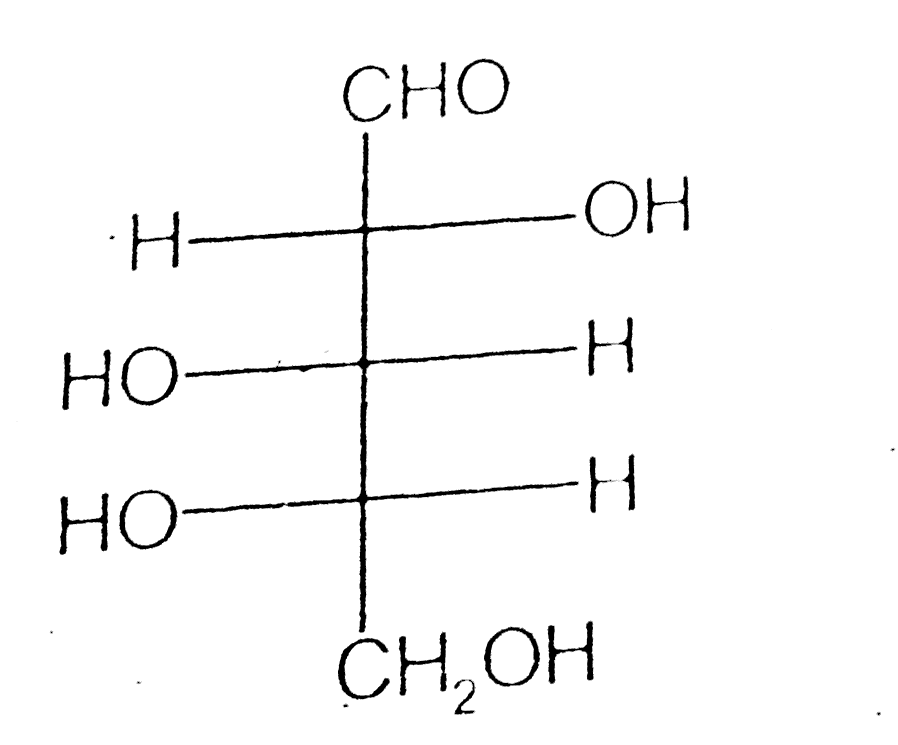Which of the following gives an optically inactive aldaric acid on oxidation with dilute nitric acid ?




The correct Answer is:C
To solve the problem of identifying which aldaric acid becomes optically inactive upon oxidation with dilute nitric acid, we will analyze each of the given options step by step.
Step 1: Understanding Aldaric Acids
Aldaric acids are a type of sugar acid that contain both an aldehyde group (CHO) and a hydroxyl group (OH) on adjacent carbon atoms. When oxidized, the aldehyde group is converted to a carboxylic acid (COOH), and the hydroxymethyl group (CH2OH) is also oxidized to a carboxylic acid.
Step 2: Oxidation with Dilute Nitric Acid
When an aldose sugar is treated with dilute nitric acid, the following transformations occur:
- The aldehyde group (CHO) at the first carbon oxidizes to a carboxylic acid (COOH).
- The hydroxymethyl group (CH2OH) at the last carbon also oxidizes to a carboxylic acid (COOH).
This results in the formation of a dicarboxylic acid, specifically an aldaric acid.
Step 3: Checking for Optical Activity
A compound is optically inactive if it possesses a plane of symmetry. To determine if the resulting aldaric acid is optically inactive, we need to analyze the structure of each product after oxidation and check for symmetry.
Step 4: Analyzing Each Option
1. Option 1:
- After oxidation, the structure does not have a plane of symmetry. Therefore, it is optically active.
2. Option 2:
- Similar to Option 1, this structure also lacks a plane of symmetry, making it optically active.
3. Option 3:
- Upon oxidation, this structure has a plane of symmetry. The arrangement of groups allows for mirror images, indicating that it is optically inactive.
4. Option 4:
- This structure also does not have a plane of symmetry, thus it is optically active.
Conclusion
After analyzing all options, we find that Option 3 produces an optically inactive aldaric acid upon oxidation with dilute nitric acid due to the presence of a plane of symmetry.
Final Answer
The correct option is Option 3.
---
Aldaric acids are a type of sugar acid that contain both an aldehyde group (CHO) and a hydroxyl group (OH) on adjacent carbon atoms. When oxidized, the aldehyde group is converted to a carboxylic acid (COOH), and the hydroxymethyl group (CH2OH) is also oxidized to a carboxylic acid.
When an aldose sugar is treated with dilute nitric acid, the following transformations occur:
- The aldehyde group (CHO) at the first carbon oxidizes to a carboxylic acid (COOH).
- The hydroxymethyl group (CH2OH) at the last carbon also oxidizes to a carboxylic acid (COOH).
A compound is optically inactive if it possesses a plane of symmetry. To determine if the resulting aldaric acid is optically inactive, we need to analyze the structure of each product after oxidation and check for symmetry.
1. Option 1:
- After oxidation, the structure does not have a plane of symmetry. Therefore, it is optically active.
- Similar to Option 1, this structure also lacks a plane of symmetry, making it optically active.
- Upon oxidation, this structure has a plane of symmetry. The arrangement of groups allows for mirror images, indicating that it is optically inactive.
- This structure also does not have a plane of symmetry, thus it is optically active.
After analyzing all options, we find that Option 3 produces an optically inactive aldaric acid upon oxidation with dilute nitric acid due to the presence of a plane of symmetry.
The correct option is Option 3.
Topper's Solved these Questions
- BIOMOLECULESBOOK - AAKASH INSTITUTE ENGLISHCHAPTER - BIOMOLECULESEXERCISE - Section-C (Objective Type Questions (More than one option is correct))
10 Videos
- BIOMOLECULESBOOK - AAKASH INSTITUTE ENGLISHCHAPTER - BIOMOLECULESEXERCISE - Section-D (Comprehension Questions )
9 Videos
- BIOMOLECULESBOOK - AAKASH INSTITUTE ENGLISHCHAPTER - BIOMOLECULESEXERCISE - Objective type question(Objective Type Questions (One option is correct))
5 Videos
- AMINES BOOK - AAKASH INSTITUTE ENGLISHCHAPTER - AMINES EXERCISE - Assignment Section -J (Aakash Challengers Questions)
9 Videos
- CHEMICAL BONDING AND MOLECULAR STRUCTURE BOOK - AAKASH INSTITUTE ENGLISHCHAPTER - CHEMICAL BONDING AND MOLECULAR STRUCTURE EXERCISE - Assignment Section J (Aakash Challengers Questions)
10 Videos
Similar Questions
Knowledge Check
Which of the following compound is optically inactive ?
ACH3⋅CHOH⋅CH2⋅CH3BH2C=CH⋅CH2⋅CH=CH2C D
D
Which of the following compounds is optically inactive?
A B
B C
C D
D
Which of the following complex is optically inactive
View SolutionWhich of the following amino acid is optically inactive?
View SolutionWhich of the following is a nitric acid anhydride?
View SolutionWhich of the following gives benzoic acid on oxidation :
View SolutionWhich of the following substances will not give carbon dioxide on treatment with dilute acid?
View SolutionWhich of the following reacts most slowly with nitric acid.
View Solution
